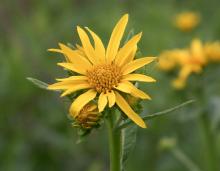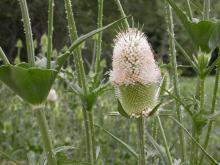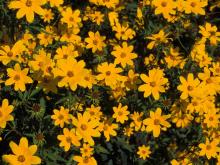Wildflowers, Grasses and Other Nonwoody Plants
Media

Species Types
Scientific Name
Ageratina altissima (formerly Eupatorium rugosum)
Description
White snakeroot looks very similar to thoroughworts, but it has triangular leaf blades that are more broadly angled or rounded at the base. White snakeroot is common statewide. It’s a toxic plant if eaten, so it’s good to be able to identify it.
Media

Species Types
Scientific Name
Eupatorium perfoliatum
Description
American, or common boneset has small, white flowerheads in flat-topped clusters at the top of the plant. The leaves are hairy, narrowly triangular, and in opposite pairs fused around the stem.
Media

Species Types
Scientific Name
Eupatorium altissimum
Description
A stout perennial that can grow to 6 feet tall, tall thoroughwort is a member of the sunflower family that has dull white flowers and distinctive leaves that are opposite, slender, very short-stalked, and with three quite noticeable veins.
Media

Species Types
Scientific Name
Verbesina helianthoides
Description
Yellow crownbeard and its close relatives are called wingstems because of lengthwise, winged ridges along the stems. Look for it blooming, May through October, in open and rocky areas.
Media

Species Types
Scientific Name
Dipsacus fullonum and D. laciniatus
Description
“Infestation” is the term for what teasels are doing in Missouri. Learn to identify these thistlelike plants, and help to control the weedy spread of these tough, prickly invaders.
Media

Species Types
Scientific Name
Ambrosia trifida
Description
Large stands of wind-pollinated giant ragweed commonly form in disturbed areas, causing late-summer misery in the form of hay fever for many Missourians.
Media

Species Types
Scientific Name
Bidens aristosa
Description
Tickseed sunflower has flattened black seeds that attach themselves to clothing and pets via two needlelike awns. In flower, it grows in massive displays in moist bottomlands.
Media

Species Types
Scientific Name
Heliopsis helianthoides
Description
Ox-eye is a sunflower lookalike. This member of the sunflower family is not a true Helianthus, but a Heliopsis. This attractive perennial is growing in popularity as a native garden flower.
Media

Species Types
Scientific Name
Helianthus tuberosus
Description
Jerusalem artichoke deserves a better common name. This tall native sunflower has edible tubers and great crop potential, but it has never been very big commercially. Fortunately, we can enjoy it for free in nature.
Media

Species Types
Scientific Name
Silphium integrifolium
Description
Wholeleaf rosinweed looks like a sunflower, but its relatively small central disk of infertile florets reveals it as a rosinweed, genus Silphium. It occurs statewide.
See Also
About Wildflowers, Grasses and Other Nonwoody Plants in Missouri
A very simple way of thinking about the green world is to divide the vascular plants into two groups: woody and nonwoody (or herbaceous). But this is an artificial division; many plant families include some species that are woody and some that are not. The diversity of nonwoody vascular plants is staggering! Think of all the ferns, grasses, sedges, lilies, peas, sunflowers, nightshades, milkweeds, mustards, mints, and mallows — weeds and wildflowers — and many more!





















